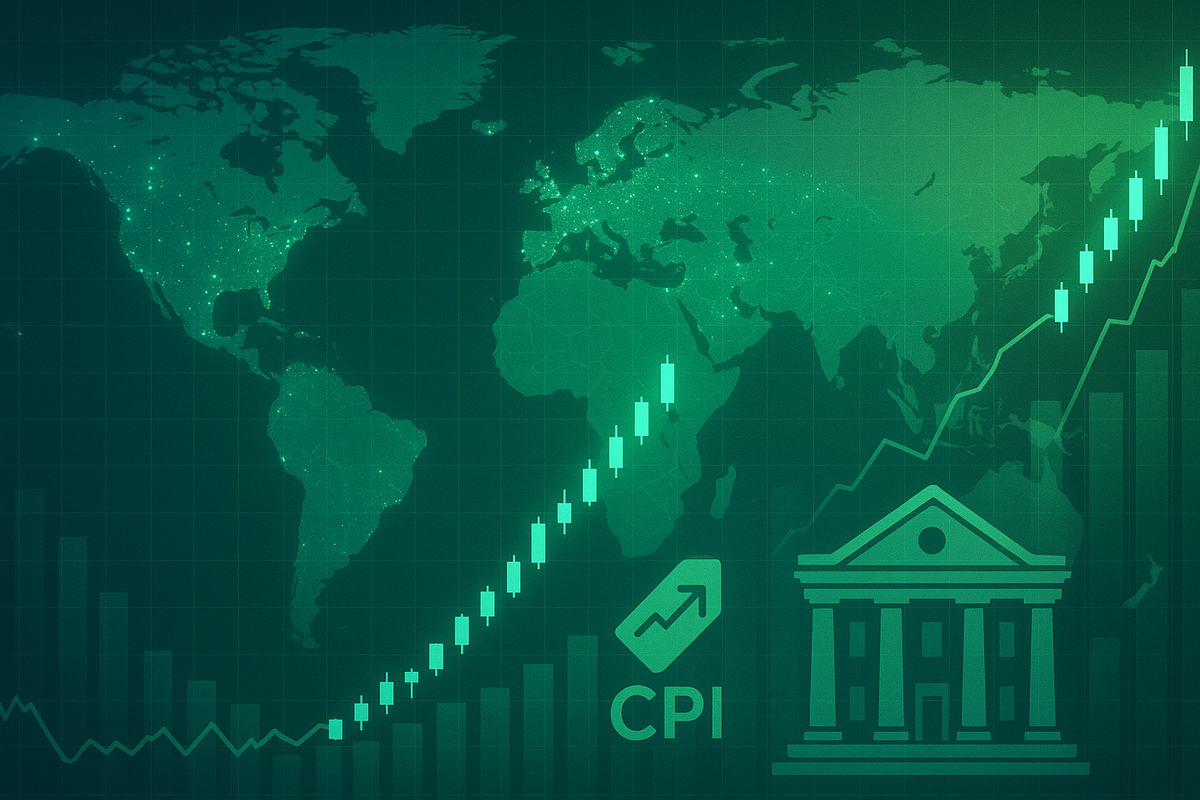
A surprisingly subdued July Consumer Price Index (CPI) report has sent ripples of optimism across global financial markets, igniting a worldwide rally and significantly recalibrating expectations for future interest rate movements. With a modest 0.2% monthly increase and a 2.7% year-over-year rise, the inflation data was largely perceived as "tame" by investors, solidifying the likelihood of an imminent interest rate cut by the Federal Reserve. This shift in monetary policy outlook has triggered a wave of buying across Asian and European bourses, signaling a potential turning point for economies grappling with persistent inflationary pressures.
The Taming of Inflation: Why July's CPI Matters
The U.S. Bureau of Labor Statistics (BLS) released its July 2025 Consumer Price Index report on August 12, 2025, revealing figures that, while still above the Federal Reserve's long-term target, were met with a collective sigh of relief from market participants. The headline CPI-U rose by a seasonally adjusted 0.2% in July, aligning perfectly with economists' forecasts and following a 0.3% increase in June. More critically, the year-over-year all-items index increased by 2.7%, remaining unchanged from June's annual rate and slightly undercutting projections of 2.8%.
Despite a slight acceleration in core CPI (excluding volatile food and energy prices), which rose 0.3% month-over-month and 3.1% year-over-year, the overall sentiment was one of reassurance. Analysts quickly pointed out that the report was "not hot enough to derail the Fed from cutting rates in September," suggesting that inflation, while present, was not spiraling out of control. Moderating components, such as a 1.1% decline in energy prices (including a 2.2% drop in gasoline) and stable food prices, contributed to this perception of tamed inflation. Even the acknowledged impact of new import tariffs imposed by President Donald Trump was described as "moderate" and "not at an alarming rate," indicating that businesses were managing cost pass-throughs without triggering widespread price surges.
This data has profoundly impacted interest rate expectations. Prior to the report, there was considerable debate about the Federal Reserve's next move. However, the July CPI, coupled with a weakening July jobs report that showed slower hiring, has significantly bolstered the case for monetary easing. While an exact 96% probability of a September rate cut was not explicitly stated in all analyses, the consensus among economists and market strategists is that a cut is now highly probable. Institutions like Morningstar and Kiplinger have echoed this sentiment, noting that the data "lifted expectations for a September rate cut" and would allow the Fed to prioritize addressing labor-market weakness.
The timeline leading up to this moment has been characterized by a delicate dance between inflation management and economic growth. After steadily cooling throughout much of 2024, inflation rates had reached their lowest points since early 2021. June 2025 saw a 0.3% monthly CPI rise and a 2.7% year-over-year increase. The data collection period for July coincided with the more noticeable impact of new tariffs. Now, with the August 12th release, the narrative has shifted decisively towards a more accommodative monetary policy. Key players in this unfolding drama include the U.S. Bureau of Labor Statistics (BLS), the Federal Reserve (Fed), a host of economists and market analysts from firms like FactSet, Morgan Stanley (NYSE: MS), and Goldman Sachs (NYSE: GS), and the U.S. Government, whose policies directly influence economic trends.
Winners and Losers in a Lower-Rate Landscape
The prospect of lower interest rates, spurred by the "tame" inflation report, is poised to create a distinct divide between winning and losing sectors and companies in the financial markets. Generally, reduced borrowing costs act as a powerful stimulant for economic activity, favoring growth-oriented industries and those reliant on consumer spending, while potentially squeezing the margins of some financial institutions.
The Beneficiaries:
The Real Estate and Housing sector stands to be a significant winner. Lower interest rates directly translate to more affordable mortgages, igniting demand for new homes and refinancing activity. This benefits homebuilders, real estate investment trusts (REITs), and real estate brokerage firms. Companies like Welltower (NYSE: WELL), a specialist in senior housing, will see reduced borrowing costs for new acquisitions and developments. Real estate technology platforms such as Zillow (NASDAQ: Z) and Redfin (NASDAQ: RDFN), which thrive on an active housing market, are also likely to experience an uptick in business. Similarly, EXP World Holdings (NASDAQ: EXPI), a real estate brokerage, could see increased transaction volumes.
Consumer Discretionary companies are also set for a boost. With lower borrowing costs for consumers on credit cards and auto loans, disposable income is expected to rise, encouraging increased spending on non-essential goods and services. This bodes well for retailers, automotive companies, and leisure and hospitality businesses. Giants like Amazon (NASDAQ: AMZN) and Starbucks (NASDAQ: SBUX) could see improved sales figures, while big box retailers such as Target (NYSE: TGT) and Walmart (NYSE: WMT), offering a mix of discretionary and staple goods, may also benefit from a more confident consumer.
Technology and Growth Stocks are particularly sensitive to interest rate movements. These companies often rely on future earnings potential, and higher interest rates discount these future earnings more heavily. Lower rates reduce this discount rate, making their future earnings more valuable and potentially leading to higher stock valuations. Furthermore, cheaper borrowing costs provide crucial funding for research and development, acquisitions, and expansion initiatives. Tech behemoths like Microsoft (NASDAQ: MSFT), Apple (NASDAQ: AAPL), Alphabet (NASDAQ: GOOG), and Meta Platforms (NASDAQ: META) could experience renewed investor interest and higher valuations. Smaller, growth-oriented tech firms may also find it easier to secure necessary funding.
Companies with High Debt Loads will also find relief. Businesses carrying substantial variable-rate debt will see their interest expenses decrease, directly improving their bottom line and increasing profitability. For instance, AbbVie (NYSE: ABBV), with its significant debt and strong cash flow, can borrow more freely and cost-effectively. Verizon Communications (NYSE: VZ), a telecom giant with a large debt load, is another prime example of a company that will benefit from cheaper debt financing. Small-cap companies, which generally carry higher debt levels, are also poised to outperform in this lower-rate environment.
Finally, Utilities and Capital-Intensive Sectors such as telecom, infrastructure, and renewable energy will benefit. These sectors require substantial capital investment for projects and operations. Lower interest rates reduce their borrowing costs for building new plants or updating infrastructure. For utilities, lower rates also make their dividend yields more attractive compared to bonds, encouraging income investors to shift into utility stocks. Constellation Energy (NASDAQ: CEG), a utility company, will find an easier path to growth with lower-cost financing.
The Challengers:
Conversely, Banks and Financial Institutions may face challenges. While lower rates can stimulate lending and increase loan activity, they can also compress net interest margins (NIMs) – the difference between interest earned on loans and interest paid on deposits. A flattening yield curve, where long-term rates fall more than short-term rates, can particularly squeeze bank profitability. Major banks like JPMorgan Chase (NYSE: JPM) and Bank of America (NYSE: BAC) could see their profitability negatively impacted by these compressed margins.
Fixed-Income Investors will also see lower returns. Individuals and institutions heavily invested in fixed-income assets like bonds may find new bonds issued with lower yields, making the overall environment for fixed-income investing less lucrative. While existing bonds with higher yields may become more attractive, the broader trend will be towards diminished returns in this asset class.
Lastly, Defensive Sectors might lose some of their relative appeal in a strong recovery scenario. While consumer staples, utilities, and healthcare tend to perform well during economic slowdowns due to stable demand, they may see less outperformance compared to growth sectors if the economy strengthens significantly. Companies like Procter & Gamble (NYSE: PG) and Coca-Cola (NYSE: KO), typically considered consumer staples, might experience less relative growth compared to their more cyclical counterparts.
Industry Impact and Broader Implications
The July CPI report and the subsequent surge in rate cut expectations are not merely isolated financial events; they represent a significant inflection point with far-reaching implications for broader industry trends, competitive landscapes, and regulatory frameworks. This potential pivot in monetary policy also invites comparisons to historical economic cycles, offering insights into what might lie ahead.
The July CPI report presented a nuanced picture: while the headline inflation rate held steady at 2.7% year-over-year, core CPI, excluding volatile food and energy prices, rose to 3.1%, its highest reading since February. This indicates persistent underlying price pressures, particularly from services like medical care and airfares, and increasingly from tariff-related increases on imported goods such as household furnishings and recreational items. Despite this stickiness in core inflation, the financial markets are exhibiting renewed optimism for a September interest rate cut, with some traders assigning a probability as high as 94%. This heightened expectation signals a potential pivot in the Federal Reserve's monetary policy, moving away from its aggressive tightening cycle towards a more accommodative stance. This aligns with a broader global trend where central banks are navigating the post-pandemic economic landscape, balancing inflation control with the imperative to avoid a recession, with the prevailing sentiment being a hope for a "soft landing."
The ripple effects of a potential September rate cut would be substantial across various industries. Lower borrowing costs would generally translate to reduced expenses for businesses, potentially boosting corporate profitability, stimulating consumer spending, and encouraging investment decisions. This could particularly benefit the Technology Sector, where lower borrowing costs could fuel increased investment in research and development, accelerating innovation and intensifying competition. Smaller, growth-oriented tech companies might find it easier to secure funding, challenging the dominance of established players. In the Financial Sector, while banks might face compressed net interest margins (NIMs) due to lower interest rates, the overall increase in economic activity driven by cheaper borrowing could lead to higher loan volumes and fee income, partially offsetting margin pressure. Conversely, traditional banking, which thrives on higher interest rates, could see compressed profit margins.
The Real Estate and Housing sectors, highly sensitive to interest rates, would likely experience a significant boost. Lower mortgage rates tend to enhance housing demand and affordability, leading to increased sales and construction activity. Real Estate Investment Trusts (REITs) could also see improved valuations as their cost of capital decreases and property values potentially rise. On a broader macroeconomic level, a weaker U.S. dollar, a likely outcome of Fed rate cuts, could make U.S. exports more competitive globally, benefiting American manufacturers and exporters. Conversely, it could make imports more expensive, potentially impacting companies reliant on imported goods. Within supply chains, competitors and partners may feel the squeeze of rising costs, particularly due to tariffs, potentially leading to renegotiated contracts, increased Mergers & Acquisitions (M&A) activity as companies seek economies of scale, or even business failures for those unable to adapt. Companies will need to prioritize cost control and efficiency improvements. Finally, a buoyant market, fueled by rate cut expectations, instills confidence, leading to increased capital flows into equities and a shift in risk appetite. This could make it easier for smaller, emerging companies to raise capital, potentially fueling further innovation and competition across industries.
The July CPI report and rate cut expectations also highlight several critical regulatory and policy considerations. The Federal Reserve's dual mandate of achieving maximum employment and price stability is continually challenged by data like the sticky core inflation, illustrating the ongoing balancing act. The report also underscores how Trump-era tariffs are beginning to seep into consumer prices, particularly for core goods. This complicates the Fed's inflation fight, as monetary policy is less effective against supply-side inflation drivers like tariffs. The recent extension of the U.S.-China tariff truce could offer some relief, but new tariffs, such as those on semiconductor imports, introduce fresh inflationary pressures. Furthermore, public criticism from President Trump regarding Fed Chair Powell and calls for lower interest rates raise concerns about the central bank's independence. The nomination of a critic to head the Bureau of Labor Statistics (BLS) could also impact the perceived objectivity of economic data, which is crucial for policy decisions. Globally, while shared economic components exist, central banks' monetary policy decisions can and should still diverge to reflect domestic economic conditions.
Historically, the U.S. has experienced seven rate-cutting cycles over the past 50 years, averaging 26 months in duration and a 6.35 percentage point reduction in rates. While inflation tended to fall during these cycles due to the slowing economic growth that typically precedes Fed cuts, it has, on average, picked back up by nearly 2 percentage points after the first rate cut in previous cycles. Most previous rate cut cycles occurred during or around U.S. recessions, as the Fed typically cuts rates to stimulate economic activity in a slowing economy. Prolonged disinflation can sometimes be accompanied by a recession and higher unemployment, as seen in the early 1980s. Historically, U.S. equity markets have generally performed well in the year following the start of Fed rate cut cycles, with the S&P 500 averaging a 14.1% return in the 12 months after the first cut since 1980. Bonds have tended to outperform during the actual cutting phase, while stocks and real estate have shown higher gains once the rate cut cycles conclude. However, volatility tends to increase around rate cut cycles, suggesting a potentially bumpy ride for investors. The current monetary policy cycle is unique due to its unusually aggressive tightening phase and a longer period of holding rates constant at their peaks compared to historical norms, along with the significant impact of tariffs.
What Comes Next: Navigating the New Economic Landscape
The July CPI report and the subsequent high probability of a September interest rate cut by the Federal Reserve usher in a new phase for the global economy, demanding strategic pivots and adaptations from businesses and investors alike. The coming months will be characterized by both short-term market adjustments and long-term economic reconfigurations.
In the short term (the next 3-6 months), financial markets are likely to experience continued volatility as participants fully digest the implications of a potential rate cut. Rate-sensitive sectors such as consumer discretionary, industrials, financials, and technology stocks may see an initial surge due to lower borrowing costs and improved corporate profitability. The S&P 500 and Nasdaq 100 have already hit all-time highs in anticipation, reflecting this optimism. A downward trend in bond yields is anticipated, and the U.S. dollar might weaken against other major currencies as the interest rate differential narrows, potentially benefiting U.S. exporters. However, despite the headline CPI holding steady, core inflation remains elevated, and the impact of tariffs imposed by President Trump is expected to continue putting upward pressure on prices in certain categories (e.g., furniture, auto parts, apparel) in the coming months. This could complicate future rate decisions beyond September, introducing a layer of uncertainty.
Looking further out (the next 1-3+ years), the long-term outlook is multifaceted. A rate cut could foster a more stable and predictable economic landscape, encouraging long-term investment and innovation. However, some economists project that core and headline CPI could peak in the second quarter of 2026, suggesting that tariff-induced price increases may have a more lasting impact than initially thought. This raises the risk of a "stagflation-lite" scenario – a combination of sluggish economic growth and persistent inflation above the Fed's 2% target. Some analysts, like Nomura, even anticipate additional rate cuts beyond September, potentially in December 2025 and March 2026, assuming the labor market remains soft and broader financial conditions remain easy.
For businesses, strategic pivots are essential. Companies should re-evaluate their capital structures, optimize debt, and consider refinancing opportunities to take advantage of cheaper financing. Businesses that prioritized cost-cutting in a high-interest-rate environment may need to shift their strategies towards growth and expansion, potentially accelerating capital expenditure plans. Industries highly sensitive to interest rates, such as real estate and automotive, may need to adjust production and sales forecasts upwards. Financial institutions, conversely, will need to adapt their business models to a lower net interest margin environment, potentially focusing more on fee-based services or expanding into new markets. Workforce planning will also be crucial, as shifting macroeconomic conditions will continue to influence corporate strategy and staffing recalibrations.
For investors, careful navigation will be paramount. Prioritizing growth stocks, particularly in technology and consumer discretionary, as well as real estate and industrials, could be beneficial. In fixed income, extending bond duration to capture higher yields in the long end of the curve and considering high-yield corporate bonds, which tend to perform well in low-rate environments, could be advantageous. Given the sticky nature of core inflation and the impact of tariffs, Treasury Inflation-Protected Securities (TIPS) and commodities like gold remain important defensive plays. While optimism for rate cuts is high, seasoned investors caution against abandoning defensive positions entirely, given the potential for late-summer volatility and lingering macroeconomic risks. Leveraging international opportunities, especially with the recent US-China tariff delay, could also be advantageous. Closely monitoring future CPI reports, labor market data (unemployment rates, wage growth), and industrial output will be crucial for informed decision-making.
Potential market opportunities include increased consumer spending and business investment, growth in specific sectors like technology, housing, renewable energy, and industrials, and potentially attractive fixed-income options. Cheaper financing could also fuel mergers and acquisitions. However, challenges persist, including squeezed margins for financial institutions, reduced appeal for traditional income stocks, and the ongoing threat of tariff-driven inflation. Any unexpected deviation from the anticipated disinflationary trend or a more hawkish stance from the Fed could trigger significant market volatility. The persistent elevation of core inflation above the Fed's 2% target remains a key challenge. The most optimistic scenario is a "soft landing," where inflation is successfully tamed without triggering a severe recession. However, less favorable outcomes could see economic growth falter despite lower rates, or a "stagflation-lite" scenario where inflation remains above target while economic growth slows. If upcoming economic data does not sufficiently signal a weakening labor market, or if core inflation remains stubbornly high, the Federal Reserve might delay or temper its rate cut, leading to market disappointment.
Conclusion: A New Chapter for the Markets
The July Consumer Price Index report marks a pivotal moment for global financial markets, signaling a potential shift from a period of aggressive monetary tightening to one of easing. The "tame" inflation figures, particularly the headline 0.2% monthly and 2.7% year-over-year increases, have significantly bolstered expectations for a September interest rate cut by the Federal Reserve, triggering a worldwide market rally. This collective sigh of relief from investors underscores the market's desire for lower borrowing costs and a more accommodative monetary policy.
The immediate implications are clear: sectors sensitive to interest rates, such as real estate, consumer discretionary, and technology, are poised to benefit from cheaper financing and increased consumer spending. Companies with high debt loads will also find relief as their interest expenses decrease. Conversely, banks and financial institutions may face compressed net interest margins, while fixed-income investors could see lower returns on new bond issuances. The broader economic landscape will be shaped by these shifts, with potential ripple effects across supply chains and international trade, particularly given the ongoing impact of tariffs.
Moving forward, investors should closely monitor upcoming economic data, especially future CPI reports and labor market indicators, as these will heavily influence the Federal Reserve's subsequent decisions. While the current sentiment is optimistic for a "soft landing," the persistent nature of core inflation and the complexities introduced by trade policies mean that vigilance is key. Businesses will need to adapt their capital structures and growth strategies to thrive in a lower-rate environment, while investors should consider rebalancing portfolios towards growth-oriented assets while maintaining some defensive positions against potential volatility. The coming months will be critical as the Federal Reserve balances its dual mandate of maximum employment and price stability amidst evolving economic data and geopolitical factors, ultimately shaping the trajectory of the market and the broader economy.





